GSTR-3B Format
Use the GSTR-3B Format by Vyapar to file your return. Avail additional features of the Vyapar best accounting app and makes your accounting and billing process seamless. A free trial period is available, so try it now!
- ⚡️ Create professional GSTR-3B with Vyapar in 30 seconds
- ⚡ Share GSTR-3B automatically on WhatsApp and SMS
- ⚡️ Connect with your parties through reminders, greetings, business cards and more

Download GSTR-3B Format in Excel
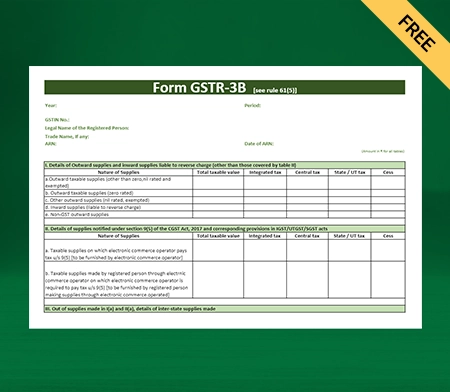
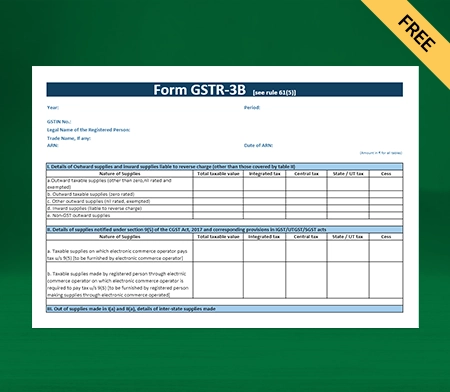
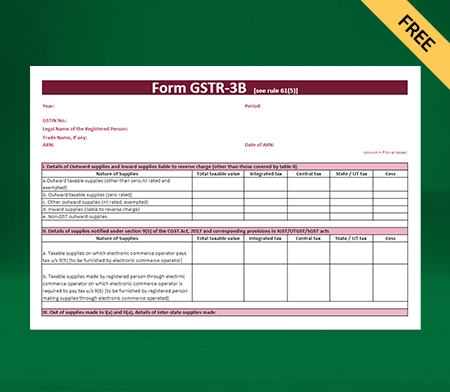
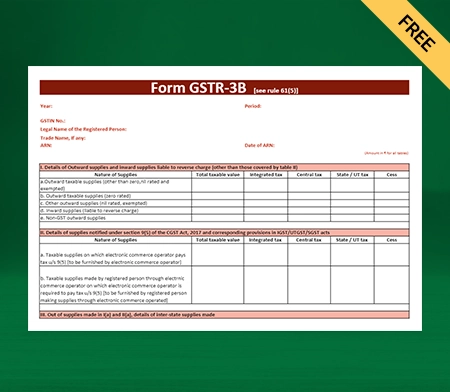
Download GSTR-3B Format in PDF
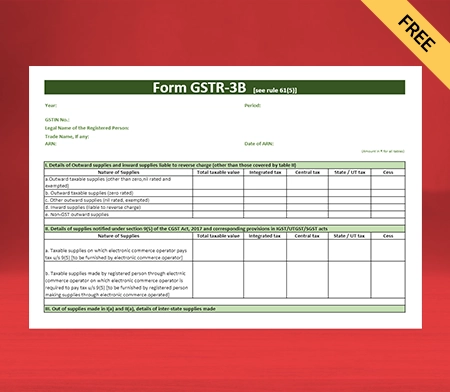
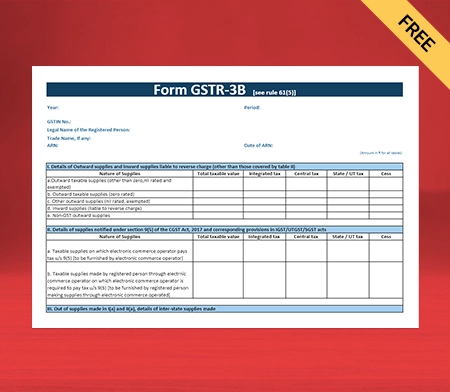
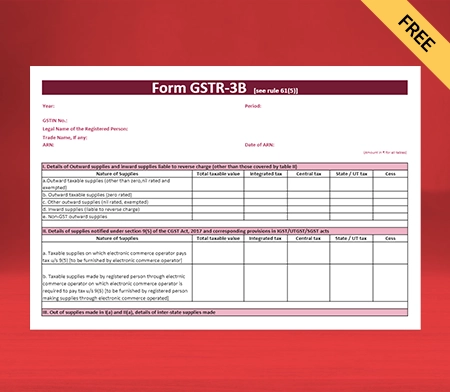
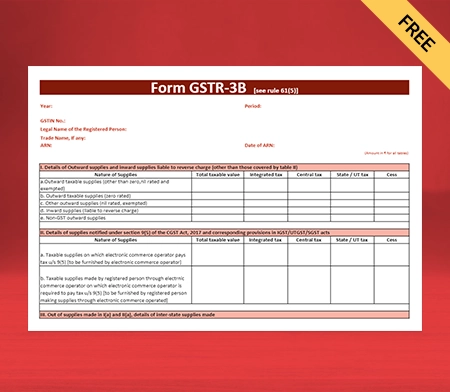
Download GSTR-3B Format in Word
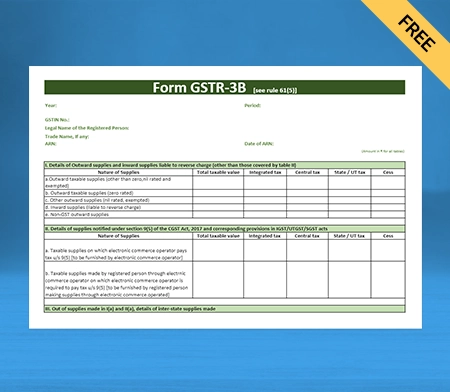
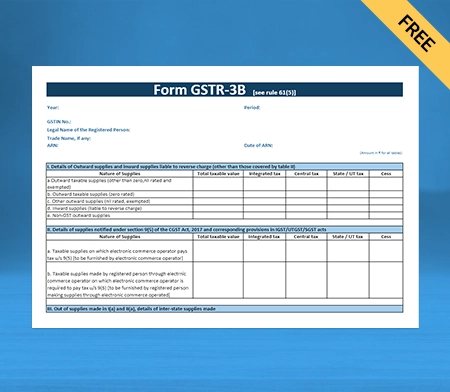
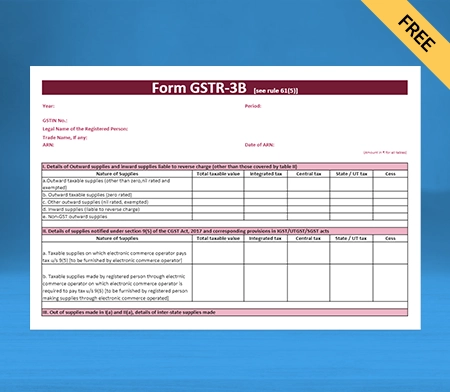
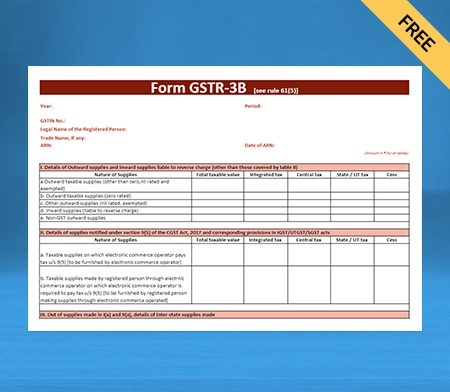
Download GSTR-3B Format in Google Docs
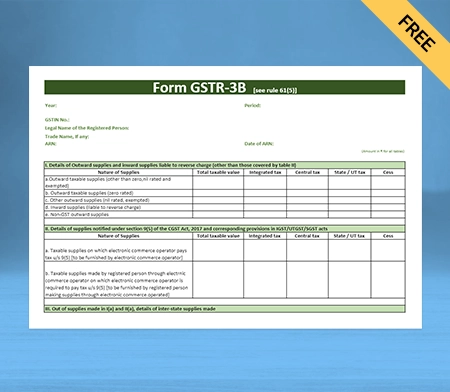
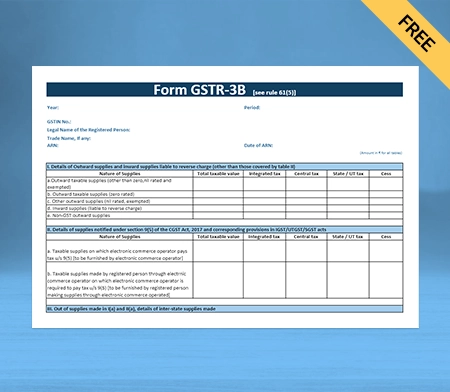
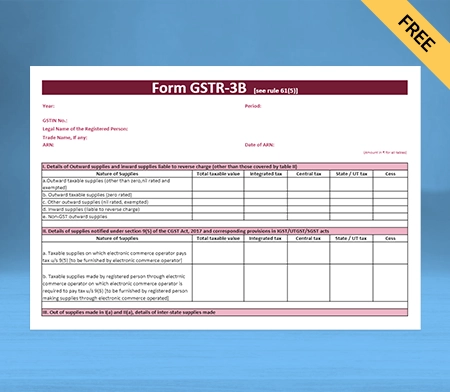
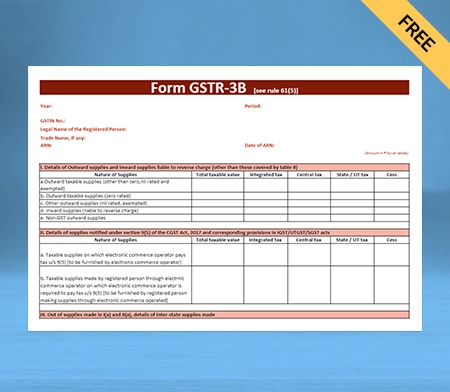
Download GSTR-3B Format in Google Sheets
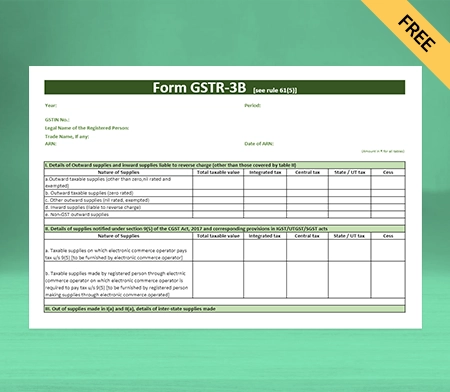
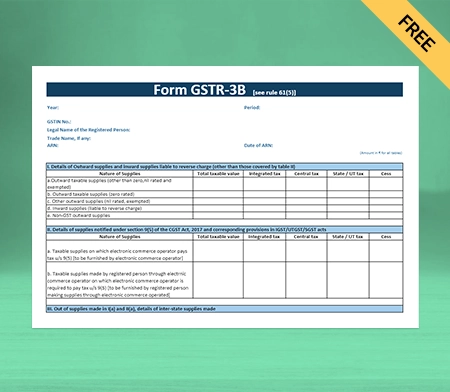
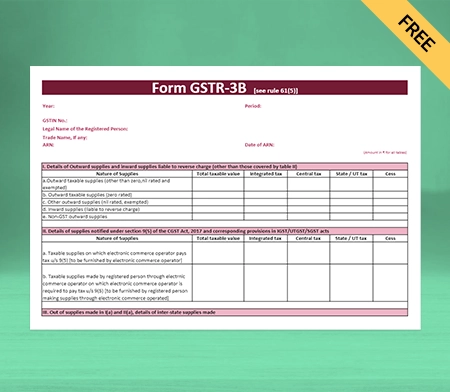
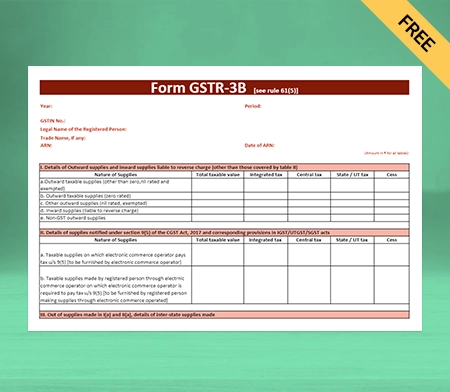
What is GSTR-3B?
GSTR-3B is a summary return of inward and outward supplies. All normal and casual taxpayers must file this return to declare their GST liabilities for a particular period.
The GSTR-3B form has 19 sections, including details of outward supplies, inward supplies, ITC claims, tax liabilities, and tax paid. The sections are as follows:
- GSTIN: The GST identification number of the taxpayer
- Name of the taxpayer
- The period for which the return is being filed
- Details of Outward Supplies and inward supplies liable to reverse charge
- Details of inter-state supplies made to unregistered persons, taxable composition persons, and UIN holders
- ITC available
- ITC Reversed
- Other ITC-related adjustments
- ITC available whether in full or part
- The details of tax paid
- Interest and late fees payable and paid
- The details of the demand and refund
- Supplies received from taxable composition persons and other exempt/nil-rated/non-GST supplies received
- Amendments to the details furnished in earlier returns in Tables 4, 5 and 6
- HSN-wise summary of outward supplies
- HSN-wise summary of inward supplies
- Documents issued during the tax period
- Information regarding payment of tax under the reverse charge mechanism
- Verification and declaration.
The GSTR-3B return is filed online on the GST portal, and the due date for filing is the 20th of the following month. The return is self-declared, and any errors or omissions must be rectified in the subsequent months’ returns.
Consequences Of Late Filing Of GSTR-3B
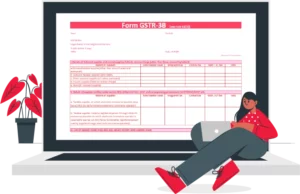
GSTR-3B is a monthly return summarising all the sales, purchases, and taxes a registered taxpayer pays under India’s Goods and Services Tax (GST) system. If you don’t file GSTR-3B on time, the following consequences may occur:
Late Fees: A late fee of Rs. 50 per day (Rs. 20 per day for nil filers) will be charged for each day of delay until the return is filed. The maximum late fee is Rs. 5,000.
Interest: Interest at 18% per annum will be charged on the amount of unpaid tax liabilities after the due date.
Input Tax Credit (Itc) Blockage: If GSTR-3B is not filed for a continuous period of six months, the Input Tax Credit (ITC) will be blocked, and you will not be able to use it to offset your tax liabilities.
Therefore, it is important to file GSTR-3B on time to avoid penalties or legal consequences.
Difference Between GSTR-3 And GSTR-3B
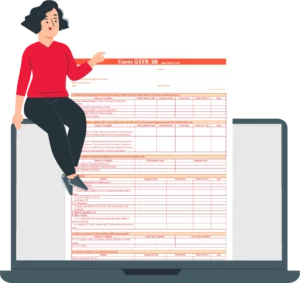
- GSTR-3 is a monthly return that businesses registered under GST are required to file, whereas GSTR-3B is also a monthly return, but it is a temporary measure that is being phased out.
- GSTR-3 is a total return that requires businesses to report all their sales and purchases along with other details such as tax liabilities, input tax credit claimed, and tax paid. GSTR-3B, on the other hand, is a summary return that requires businesses to provide a summarised version of their outward supplies and input tax credit claims.
- GSTR-3 and GSTR-3B have different formats. GSTR-3 is a detailed form that requires businesses to provide a lot of information, whereas GSTR-3B is a simpler form that requires only a summary of information.
- GSTR-3 allows businesses to claim the input tax credit on all purchases made during the month, whereas GSTR-3B format allows businesses to claim the input tax credit on a provisional basis based on self-assessment.
- The due date for filing GSTR-3 is the 20th of the month following the tax period, while the due date for GSTR-3B is the 20th of the following month.
- GSTR-3B was introduced as a temporary measure to help businesses transition to the GST regime, while GSTR-3 is a permanent monthly return that businesses must file.
- GSTR-3 requires businesses to provide many details, such as sales and purchase invoices, input tax credit claimed, and tax liabilities, while GSTR-3B requires only a summary of the same.
- GSTR-3 is a more complex return that requires businesses to provide a lot of information and reconcile data, while GSTR-3B is a simpler return that requires only a summary of information.
- Input tax credit claimed through GSTR-3 is available permanently, while TDS and TCS credit claimed through GSTR-3B is provisional and subject to adjustment during the final assessment.
How Do I File the GSTR-3B Return?

Step 1: Access The Gst Portal:
Login to the GST portal with your valid credentials.
Step 2: Go To Return Dashboard:
- On the dashboard, click on Services > Return > Return Dashboard.
- The “file return” page will appear. Select the financial year, quarter, and month from the drop-down list for which you want to file the return.
- Click on the search button.
Step 3: File Return Page:
- It will show a detailed file return page. Go to the return filing period and click the “prepare online” button.
Step 4: Answer The Questions:
- You will see a list of questions that you need to answer to show the relevant sections of Form GSTR-3B as applicable to you.
- Click on the “Next” button after answering the questions.
- The relevant tables of form GSTR-3B will appear based on your answers.
- If you want to return to the previous screen, click the “back” button.
Step 5: File The Nil Returns:
You can file nil returns if you have not made any outward supply, have not received any goods/services (purchase), and do not have any tax liabilities for that tax period.
Here’s how you can file Nil Returns on GSTR-3B:
- Select “yes” for Option A
- Click the “next” button
- Preview Draft GSTR-3B
- File GSTR-3B
- Download the Filed Return
Step 6: File Non-Nil Returns:
- The system-generated summary for GSTR-3B is displayed. The page you would have landed upon would display the details of the GSTR-3B table, Source Form, Form Status, Summary Status, and advisory.
- Click the “close” button to view the Form GSTR-3B- monthly return page.
Step 7: Monthly Return Page:
- Click on the “system generated GSTR-3B” at the bottom to download and view the system-computed details.
- Also, if necessary, you can change the automatically filled values. You can submit GSTR-3B with the modified values.
- The details in PDF will be generated per month if you have opted into filing both GSTR-1 and GSTR-3B quarterly and have filed GSTR-1 and opted to/out to file the IFF for the first two months of the quarter.
Step 8: Fill In The Necessary Information:
- You will see the appropriate tiles for entering the information based on your choice on the previous page.
- Enter details of tax on outward taxable supplies zero rated and reverse charge inward supplies, supplies notified under section 9(5) of the CGST Act, inter-state supplies, eligible ITC, exempt, nil and Non-GST inward supplies, interest, and late fee.
Step 9: Save GSTR-3B Form:
- After all the information is entered, click the “save GSTR-3B” button at the bottom of the page. The GSTR-3B main page has a “save GSTR-3B” button that you can use to save the data you enter and return to it later to make changes.
- When you save, a notification indicating that your data was successfully saved is shown at the top of the page.
Step 10: Submit GSTR-3B:
- Click the “submit” button at the bottom of the page once all the information has been saved. Your completed GSTR-3B return form has been submitted. At the top of the page, a success message is displayed.
- After Form GSTR-3B is submitted, the newly inserted data is locked and cannot be changed.
- On submission, the ITC and Liability ledger is also updated.
- The GSTR-3B’s status has been updated to “submitted.”
Step 11: Preview Draft GSTR-3B:
- To view the summary page of Form GSTR-3B for review, scroll down the page and click the “preview draft GSTR-3B” button.
- The GSTR-3B draft summary can be downloaded from this button so you can evaluate it before filing.
- Before making the payment, it is advised that you download the final summary page and go over the entries made in the various parts.
Step 12: Tax Payment:
Once the return has been successfully submitted, the “payment of tax” tile is enabled. Here’s how you can pay taxes and offset your liabilities:
- Click on the “payment of tax” tile.
- Upon submission of GSTR-3B, the ledger is updated to reflect the tax liabilities as reported in the return and the credits.
- They are shown in the payment section’s “tax payable” column.
- Credits are changed in the credit ledger, and the revised balance is visible when you hover over particular payment section headings.
Step 13: File GSTR-3B:
- Click on the “proceed to file” at the bottom right corner to file the GSTR-3B.
- Select the declaration checkbox.
- Select the authorized signatory from the drop-down list.
- Click the “File GSTR-3B with EVC” button.
- You must verify with the OTP.
Click the “Ok” button once the success message is displayed. Your GSTR-3B form’s status will be changed to “Filed”.
How to file GSTR-3B using Vyapar
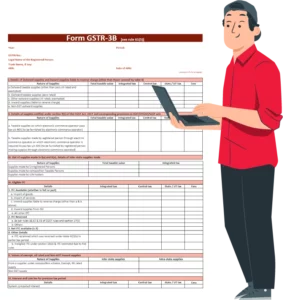
Open Vyapar desktop software.
Go to the report section, then GST reports, and click on GSTR-3b.
Choose the month of filing the return.
Enter the information regarding outward supplies, inward supplies liable to reverse charge, and details of interstate supplies made to unregistered persons or composite dealers.
Fill in the details of eligible input tax credit, details of exempt, nil rated and non-GST inward supplies.
After entering all the necessary details, save the file in Excel.
Go to the GST portal and convert your Excel file into JSON format using the free tools available on the website.
Upload the generated file on the portal.
Review and submit the GSTR-3B return.
Benefits Of Using a GSTR-3B Format By Vyapar
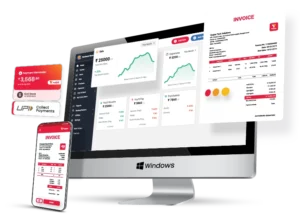
Vyapar’s GSTR-3B format is intended to be user-friendly and straightforward. It guides businesses through filing their returns step by step, making it simple even for non-experts.
1. Easy To Use:
Accounting Software Vyapar offers a user-friendly interface that simplifies the process of filing GSTR-3B returns. Users can easily navigate through the different sections of the return and input the required details.
Even those with little or no experience submitting GST returns will find the format simple. It can shorten the time and effort needed to learn the software, which is especially beneficial for businesses with limited resources or time constraints.
2. Saves Time:
The GSTR-3B format is a summary return with only the essential details required for filing taxes. This makes filing returns much quicker and easier, saving businesses time.
The GSTR-3B format from Vyapar automates data entry by importing data from invoices and other transactions documented in the software. It removes the need for time-consuming and error-prone manual data entry.
The GSTR-3B format from Vyapar saves time by automating data input and calculation. Validation checks are built into the software to ensure the accuracy of the data being input. This cuts down on the time needed for manual error verification and correction.
3. Filing The Return Accurately:
Vyapar ensures that businesses file their GSTR-3B returns on time and accurately. This helps them stay compliant with GST regulations and avoid penalties.
Vyapar’s GSTR-1 format guarantees that all required information is included in the return, ensuring accuracy and minimizing errors. The platform provides real-time updates on the status of your return, allowing you to remain up to current on the status of your filing.
Vyapar uses advanced algorithms to calculate taxes accurately and input tax credits and other details required for filing GSTR-3B returns. This helps businesses avoid errors and ensure accurate filings.
4. Consistency Is Maintained:
The GSTR-3B format developed by Vyapar offers a standardized template for reporting the summary of outward supplies of products and services. It defines the fields that must be completed and the format in which the data must be presented.
The format ensures that all businesses submit their data consistently. A consistent format ensures that all returns are filed similarly, making it simpler for tax authorities to examine and verify the information.
Vyapar’s GSTR-3B format provides a consistent method for reporting sales and supplies, which helps eliminate variations in reporting formats across companies. This lowers the possibility of inconsistencies.
5. Standard Formats:
The Vyapar programme adheres to a standard GST return structure, making it easier for businesses to prepare and file their returns. The form guarantees that all required information is included and that the return has no errors or omissions.
The billing software includes tools for managing and organizing GST-related data, such as customer information, invoice data, and tax rates.
Many operations in preparing and filing GST returns, such as data entry, tax calculation, and report production, are automated by Vyapar GSTR-1. This automation saves time and decreases the possibility of mistakes.
6. Affordable To Use:
Vyapar offers affordable pricing plans that cater to the needs of businesses of all sizes. This makes it an ideal choice for small and medium-sized enterprises looking to simplify their tax filing process.
Your GSTR-3B Format can be emailed rather than mailed. After printing a digital copy of your GST form, you can physically fill in the details, which only takes a few minutes. Alternatively, you can input them before printing.
The GSTR-3B Format can be downloaded for future use by the customer. You can modify the GSTR-3B Format to meet your specific requirements. The GSTR-3B Format is compatible with standard and thermal printers and any standard bill format.
Amazing Features Of the Vyapar App:
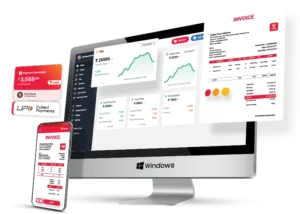
Generate Invoices Easily:
The app provides customizable free invoice templates that enable users to create professional-looking invoices. Vyapar free invoicing software allows users to create and customize invoices and estimates with their logo, brand colours, and payment terms.
The app allows users to create an item and product database, which can be used to add items to the invoice with just a few clicks. This saves time and reduces errors.
Vyapar app automatically calculates taxes, discounts, and other charges for each invoice, based on the user’s preferences. Vyapar app allows users to track the status of their invoices in real-time, so they know when the invoice is viewed, paid, or overdue.
The app sends automated payment reminders to customers, reducing the time and effort required to follow up on unpaid invoices. The app offers multiple payment modes, including cash, card, UPI, and net banking, making it easy for customers to pay.
Inventory Management:
The app enables users to track their inventory levels in real-time, allowing them to know exactly how much stock they have and when they need to reorder. Inventory Management Software Vyapar sends automatic alerts when an item’s stock level reaches a predefined minimum threshold.
Vyapar app supports barcode scanner, enabling users to add items to their inventory and quickly track them. The app allows users to categorize their products based on different criteria, such as product type, vendor, or location.
The app enables users to adjust their stock levels manually, for example, to account for damaged or lost products. The app allows users to create and send purchase orders to vendors, making tracking orders and managing inventory levels easier.
The Vyapar app generates reports that provide detailed information on stock levels, sales, and purchases. This enables users to make data-driven decisions about their inventory management.
Data Security:
Vyapar app takes data security very seriously and provides various features to protect user data. The app provides automatic cloud backup of user data, ensuring that data is always accessible, even if the device is lost or damaged.
Vyapar app uses encryption to protect user data, ensuring that data is secure and cannot be accessed by unauthorized users. The app allows users to set access controls, restricting access to sensitive data and ensuring that only authorized users can view or modify data.
Vyapar app requires users to set a strong password and provides additional security features such as biometric authentication, ensuring that user data is protected from unauthorized access.
The app uses secure data transfer protocols, ensuring user data is not intercepted or compromised during transmission. It provides regular updates to ensure that the app remains secure and up-to-date with the latest security features and protocols.
Bank Account Management:
The app integrates with users’ bank accounts, allowing them to view their account balance, transactions, and statements directly within the app.
Vyapar app provides automatic bank reconciliation, enabling users to match their bank transactions with their accounting records and ensuring that their books are up-to-date and accurate.
Vyapar app allows users to transfer funds between their bank accounts directly within the app, saving them time and effort.
The app integrates with popular payment gateways, enabling users to accept online customer payments and facilitating faster and more secure transactions.
Gst Compliance:
The app allows users to generate GST-compliant invoices, including tax calculations, invoice numbering, and HSN/SAC codes. Vyapar app makes it easy for users to file GST returns directly from the app without needing external software.
The app enables users to generate E-way bills required to move goods worth more than Rs 50,000. Vyapar app provides step-by-step guidance for businesses to register for GST and obtain their GST identification number (GSTIN).
The app helps users reconcile their GST transactions with their accounting records, reducing errors and ensuring compliance. The app keeps users up-to-date with the latest GST rules and regulations, ensuring they comply with the law.
The Vyapar app generates reports that provide detailed information on GST transactions, returns, and liabilities. These reports enable businesses to stay on top of their GST compliance requirements.
Track Expense:
Vyapar enables users to record their business expenses, including bills, purchases, and payments, and categorize them by type, date, and vendor. It supports receipt scanning, allowing users to capture and add receipts to their expense records.
Users can categorize their expenses based on criteria such as expense type, vendor, or project. This makes it easier to manage expenses and generate reports.
Vyapar small business accounting software automatically records expenses made through the app, such as payments made to vendors, saving users time and effort.
The app allows users to set and track their budgets, providing real-time insights into their expenditures against the budget. This helps businesses stay within their financial limits and avoid overspending.
Frequently Asked Questions (FAQs’)
GSTR-3B is a monthly summary return that businesses in India must file under the Goods and Services Tax (GST) regime. It is a simple summary return that contains the details of outward supplies, inward supplies, and input tax credit (ITC) claimed.
The GSTN portal makes it simple to submit the GSTR-3B form. Taxes can be paid in the form of challans in banks or online.
GSTR-3B is a monthly return, but you can file it quarterly if you opt for the QRMP scheme.
GSTR-3 includes data on inward and outward supplies, input tax credits, and tax liabilities. GSTR-3B, on the other hand, is a streamlined form that only needs total turnover, tax liabilities based on outward supplies, and input tax credit.
Any taxpayer with a turnover of more than Rs. 5 crores can file the form GSTR-3B.
Any person registered under GST and with a valid GSTIN (Goods and Services Tax Identification Number) can file GSTR-3B monthly return. The return can be filed online on the GST portal using the registered login credentials.
All normal and casual taxpayers must file GSTR-3B even if there is no business during the particular tax period.
If you don’t file GSTR-B on time, you must pay interest and late fees prescribed under the GST regulations.
Once you have submitted your GSTR-3B return, you can not revise it. However, you can make adjustments while filing GSTR-3B for the subsequent period.
GSTR-3B format changed in July 2022. Now requires more details on e-commerce supplies (Table 3) and Input Tax Credit (ITC) (Table 4). This means separate reporting of eligible vs ineligible ITC, restricted ITC, and reversed ITC.
Related Posts:



